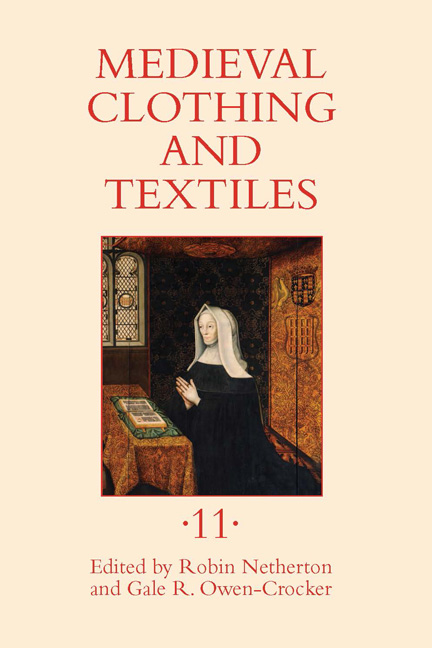Book contents
- Frontmatter
- Contents
- Illustrations
- Tables
- Contributors
- Preface
- 1 Production, Quality, and Social Status in Viking Age Dress: Three Cases from Western Norway
- 2 The Effect of Spindle Whorl Design on Wool Thread Production: A Practical Experiment Based on Examples from Eighth-Century Denmark
- 3 The Shirt Attributed to St. Louis
- 4 Angevin-Sicilian Sumptuary Statutes of the 1290s: Fashion in the Thirteenth-Century Mediterranean
- 5 The Devil on My Tail: Clothing and Visual Culture in the Camposanto Last Judgment
- 6 “Transposing þe shapus þat God first mad them of”: Manipulated Masculinity in the Galaunt Tradition
- 7 Textiles and Dress in the Household Papers of Lady Margaret Beaufort (1443–1509), Mother of King Henry VII
- 8 “Like two artificial gods”: Needlework and Female Bonding in A Midsummer Night's Dream
- Recent Books of Interest
- Contents of Previous Volumes
Preface
Published online by Cambridge University Press: 05 December 2015
- Frontmatter
- Contents
- Illustrations
- Tables
- Contributors
- Preface
- 1 Production, Quality, and Social Status in Viking Age Dress: Three Cases from Western Norway
- 2 The Effect of Spindle Whorl Design on Wool Thread Production: A Practical Experiment Based on Examples from Eighth-Century Denmark
- 3 The Shirt Attributed to St. Louis
- 4 Angevin-Sicilian Sumptuary Statutes of the 1290s: Fashion in the Thirteenth-Century Mediterranean
- 5 The Devil on My Tail: Clothing and Visual Culture in the Camposanto Last Judgment
- 6 “Transposing þe shapus þat God first mad them of”: Manipulated Masculinity in the Galaunt Tradition
- 7 Textiles and Dress in the Household Papers of Lady Margaret Beaufort (1443–1509), Mother of King Henry VII
- 8 “Like two artificial gods”: Needlework and Female Bonding in A Midsummer Night's Dream
- Recent Books of Interest
- Contents of Previous Volumes
Summary
Medieval Clothing and Textiles begins its second decade with a volume exhibiting its desired eclecticism, ranging from early medieval to early modern, from northern to southern Europe, though archaeology and artifact study, literary and documentary text, art and experimental reconstruction. Two papers focus on cloth manufacture in the early medieval period: Ingvild Øye examines the graves of prosperous Viking Age women from Western Norway that contained both textile-making tools and the remains of cloth, considering the relationship between tools and cloth. Karen Nicholson complements this with practical experiments in spinning, using tools of different weights and shapes. Tina Anderlini analyzes a surviving thirteenth-century shirt famously attributed to King Louis IX of France (St. Louis). Examination of the garment, out of its shrine for the first time since 1970, newly reveals details of cut and construction, contributing to the debate of whether it could indeed have belonged to the king. Three papers address fashionable clothing and morality: Sarah-Grace Heller discusses sumptuary legislation from Angevin Sicily in the 1290s, which sought to restrict men's dress at a time when preparation for war was more important than showy clothes; Cordelia Warr presents the dire consequences of a woman dressing extravagantly as portrayed in a fourteenth-century Italian fresco; and Emily Rozier recounts the extremes of dress attributed by moral and satirical writers to the fourteenth-and fifteenth-century men known as “galaunts.” Two textual studies show the importance of textiles in daily life: Susan Powell describes the austere but magnificent purchases made on behalf of Lady Margaret Beaufort, mother of King Henry VII, in the ten years before her death in 1509, from the evidence of her household papers. Anna Riehl Bertolet explores in detail the passage in Shakespeare's A Midsummer Night's Dream in which Helena passionately recalls sewing a sampler with Hermia when they were young and still bosom friends.
We welcome Lisa Monnas to our editorial board, an international team of experts who have provided us with great wisdom since the inception of our journal.
- Type
- Chapter
- Information
- Medieval Clothing and Textiles 11 , pp. xiii - xivPublisher: Boydell & BrewerPrint publication year: 2015

